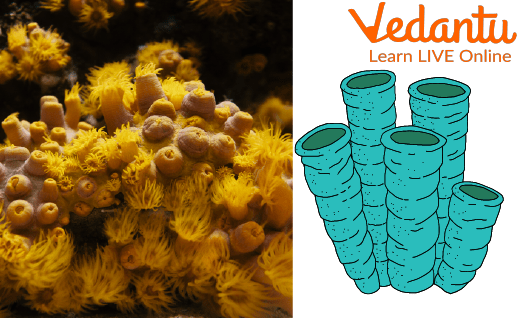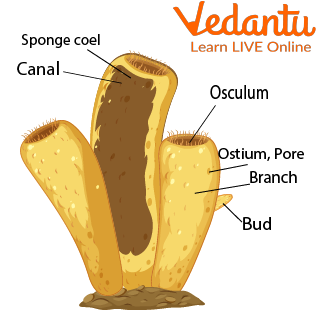




Where Are Sponge Fish Found and Why Are They Unique?
Have you ever come across a fish that is stuck to the ocean floor? A fish that does not move around as much as other fish do, perhaps a fish that does not move at all? This amazing fish resembles plants more than it resembles animals. They get their name from their ‘pore-bearing’ structure and are thus called “sponges”
Sponge fish or sponge corals are aquatic animals found in saltwater. They are often found attached to an underwater rock or a coral. Sponge sea animals have some pretty cool features; let’s look into them in some detail in this article.

Sponge Fish
Parts and Functions of a Sponge Fish
It is interesting to note that sponge sea animals are made of cells that are also found in your body. Technically, these cells are a little less developed while the cells we have in our body are more complex, performing more or less the same function. They have a modified skeletal system, muscle cells, immune cells, germ cells for reproduction, and even bone cells.
Sponges have several functions like movement, respiration, reproduction, and coordination of various activities. These species are important for humans as they were used for cleaning before synthetic sponges came into existence. Several antibiotics (medicinal uses) are also produced from sponge fish.

Parts of a Sponge
Where are Sponge Fish found?
Sponges thrive in clean, quiet water like in oceans but at a depth. This is to prevent their pores from being blocked due to ocean currents or mud sediments. They are usually found at a depth, in attachment to firm surfaces like rocks.
They find it difficult to attach themselves to softer surfaces but do so in rare circumstances.
Sponge fish are rarely found in the oceans near the equators; they are more common in the colder oceans which are close to the poles.
Sponges are an important part of the coral reef ecosystems. They help produce important gases for the survival of the coral reef. These are known as sponge corals

Sponge Corals
Interesting Facts about Sponge Fish
Sponges have an open circulatory system. Their circulation depends on the flow of water in and out of the pores present in their body. Sponge fish can reproduce sexually (involving both parents) as well as asexually (either one of the parent). Due to this nature, they are given the fancy name ‘hermaphrodites’.
Their scientific name is ‘Porifera’ which means ‘pore-bearing’. Today’s sponges have a very slow-moving mechanism called ‘cell transportation’ which makes it seem as though they are immovable. Their movement from place to place takes forever! These species live for approximately 2300 years on average!
Summary
Sea sponges or sponge fish are interesting marine creatures often found in quiet, clean waters at a depth. They are found attached to the rocks or any firm surface on the ocean floor.
Today’s sponges obtain their name due to their sponge-like texture, these species have an open circulatory system and simple cells performing functions like respiration, reproduction, movements, digestion, circulation, excretion, etc.
Sponges attached to coral reefs are called coral sponges. These creatures help balance the coral ecosystem by producing necessary gases like oxygen and carbon dioxide for the survival of both the corals as well as the sponges themselves.
FAQs on Sponge Fish Explained: Definition, Features & Examples
1. What are sponge fish and where are they found?
Sponge fish, more commonly known as sponges, are simple aquatic animals belonging to the phylum Porifera, which means 'pore-bearing'. Despite their plant-like appearance, they are animals. They are typically found in saltwater environments, from shallow waters to the deep sea, where they live attached to underwater rocks, corals, or the seafloor.
2. Why are sponges often confused with plants?
Sponges are often mistaken for plants primarily because they are sessile, meaning they stay fixed in one place for their entire adult lives, just like a plant. They also lack recognisable animal parts like a head, eyes, or limbs. However, unlike plants, sponges cannot produce their own food through photosynthesis and must consume other organisms to survive, which is a key characteristic of animals.
3. What are the main characteristics of a sponge?
Sponges have several unique characteristics that distinguish them from other animals. Key features include:
Porous Body: Their bodies are full of pores and channels that allow water to circulate through them.
Filter-Feeding: They feed by filtering out tiny food particles like bacteria and plankton from the water that flows through them.
No True Organs: They lack complex organs, a nervous system, or a digestive system.
Simple Skeleton: Their structure is supported by a simple skeleton made of fibrous protein (spongin) or hard, spiky structures called spicules.
4. What do sponges eat and how do they feed?
Sponges are carnivorous filter-feeders. They eat by drawing water into their bodies through their numerous small pores. Inside, specialised cells called choanocytes capture microscopic food particles, such as bacteria, algae, and organic debris, from the water. The filtered water then exits through a larger opening called the osculum. This efficient feeding method also helps to clean the surrounding water.
5. How are sponges useful to humans and the marine ecosystem?
Sponges play a vital role both for humans and in their natural habitat. For humans, natural sponges have been used for centuries as cleaning tools and applicators. More importantly, they produce unique chemical compounds that are studied for their potential use in medicines and antibiotics. In the ocean, they provide crucial shelter for small fish, shrimp, and crabs, and they contribute to the health of coral reefs by filtering water.
6. How do sponges create new sponges?
Sponges have a remarkable ability to reproduce in several ways. They can reproduce asexually through budding, where a small piece breaks off and grows into a new, genetically identical sponge. They are also famous for their power of regeneration; even if broken into tiny pieces, the cells can reassemble to form a new sponge. Additionally, they can reproduce sexually by releasing sperm and eggs into the water to create larvae that swim to a new location and grow.
7. Is it safe to touch a sea sponge if you find one?
It is generally best to avoid touching sponges you find in the ocean or on the beach. While many species are harmless, some sponges can produce toxins as a defence mechanism. Touching them can cause skin irritation, rashes, or a condition known as sponge dermatitis. It is always safer to observe marine wildlife from a distance to protect both yourself and the creature.





















